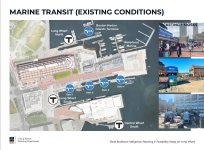Just commenting on the tech here, and not on the viability of faster ferry routes... theres definitely a wiff of wunderwaffe about that electric hyrdofoil. At this point, technologically, hydrofoils have more or less fully lost their speed advantage to catamarans, which are often partially foiling anyways - its called a T foil. While the Boeing 929 I rode in Hong Kong maxes out at 45 knots and is one of the fastest designs out there, a modern Incat catamaran can hit 50+, with the HSC Francisco down in Uruguay hitting 58kts. That electric P12 they're touting only hits 25kts with 30 passengers - Incat just launched the all electric HSC China Zorrilla for operations in Uruguay which will also operate at 25kts while carrying 2100 passengers and 200 cars, and the
smaller electric ferry with a 400 passenger capacity that they're building for San Francisco will also operate at 25kts. 25kts is not particularly fast when it comes to a ferry - in fact, the MBTAs own circa 2018 catamarans the
Champion & Glory have a design service speed of
26kts, topping out at 30kts, and the Ava Pearl &
Schodic Explorer that run to Winthrop were built to operate at
28kts.
Switching to that Swedish thing would, at the moment, actually represent a loss in speed and capacity. Theres some nuance about getting higher speed in a smaller ship that may favor hydrofoils, but im generally leery. Its definitely worth considering replacing the older monohulls, but I think with catamarans, not hydrofoils. Specifying a service speed of 35kts, a 40% increase from 25kts, is fully within their
capabilities.
Plus, having ridden an hydrofoil ferry (in Hong Kong & in the Mediterranean) my understanding is that they come with some significant drawbacks, especially in open ocean. The foil is super vulnerable to hitting anything under the water, and In rough seas, they are *significantly* less comfortable than an conventional ferry, and often can't plane at all, leading them to be slower than a modern catereman ferry in all but very calm waters. I believe as a result almost all current hyrofoil ferry routes are in protected waters; either coastal inlets, like Hong Kong and the Japanese archipelago, or on inland seas, lakes and rivers. Sure, modern control systems can probably go a long way, but i don't think they're proven in open ocean. Boston Harbor maybe, but I would be leery of sending it beyond.
Lastly... I don't believe any offer the amenities people like about ferries - they're so exposed to spray i dont think any, including this electric one, offer any outdoor deck space for passengers, and as theyre so weight sensitive, theyre usually cramped and have less space for bikes and other things. Every one I've ever even looked at was set up much more like the economy cabin of an airliner than a comfy ferry ride.





